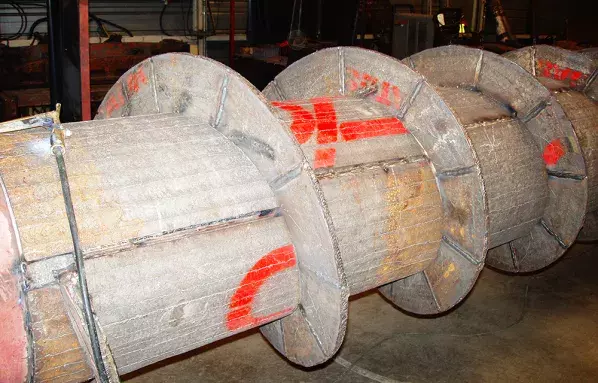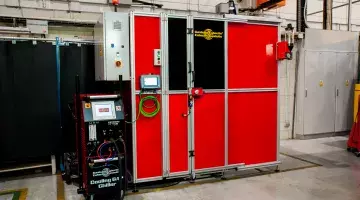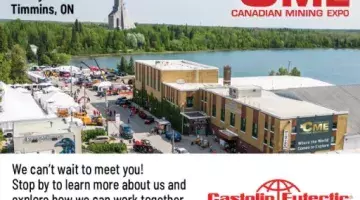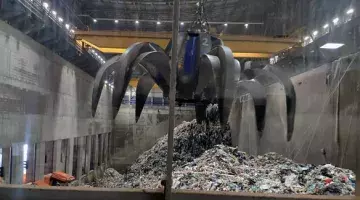Maintenace & Repair jobs for Waste & Recycling plants keep the circular economy turning

Advanced wearfacing technologies are a key to cutting equipment downtime, maintenance and operating costs in the waste and recycling industry. Mickael Guellil, Castolin Eutectic Services Manager Europe South West, explores the diversity of solutions now available.
This sector handles a very wide spectrum of abrasive and erosive materials which come into contact with potentially vulnerable metal surfaces during waste collection, transport, shredding and further processing. They range from concrete, vehicle metal and tyres, through wood, plastic and glass, to mixed domestic refuse and sewage. Processing of non-recyclable waste may end with incineration, in which equipment surfaces are subjected to corrosion as well as other forms of wear.
The most obvious ill-effect of wear in these systems is shortened component life, leading to replacement, repair and labour expenses. Failure of components during operation, resulting in unplanned downtime, is especially costly, inconvenient and increases carbon emissions.
Wearfacing – or hardfacing as it is sometimes known – answers these issues. As well as extending the life of parts and equipment, it maintains their original shape, dimensions and other qualities for optimum performance and energy efficiency.
Tyres
End-of-life vehicle tyres are often shredded before further processing as incinerator fuel or conversion into rubber crumb for use in road, sport and play area surfaces. The rotor blades, teeth and knives of tyre shredders are subject to metal-to-metal wear from steel belts in the tyres, as well as extreme abrasion from structural fibres and the rubber itself. Impact shocks can also cause damage and wear.
Castolin Eutectic uses advanced alloys in its range of welding wires to hardface these cutting surfaces, maintain their sharp edges and reduce the force and energy required to cut.

Vehicles
While vehicle recycling is a distinct industry subsector, similar principles apply to the processing of other large items such as kitchen appliances. Initially, transport and handling challenges are involved, here the correct choice of welding wires can provide the necessary reinforcement and protection in order to avoid suffering aggressive wear from metal-to-metal contact and shocks.
The general principle of vehicle crushing, ripping, tearing and shredding machines is similar to that of a coffee grinder. Hammers, discs and other cutting elements, attached to a turning rotor, smash the feed metal against an alloy steel breaker bar or anvil. This breaks it into pieces, which continue to be dragged around the rotor’s housing and chopped again until they are small enough to drop through holes in the grate below.
Unsurprisingly, the rotor discs, hammers, impact bars and linings can quickly become worn. Coating these parts with one of Castolin Eutectic’s special alloys rapidly provides work-hardened, crack-free surfaces. Additional options include the use of welding electrodes to coat the abraded sides of the discs and welding wires to hardface the hammers. In every case, a recommendation is made on which product or combination of products will be most effective.
Shredder systems include separators which split the shredded material into ferrous and non-ferrous scrap streams. Dust from the non-metallic crushed parts is captured by cyclones or other de-dusting mechanisms. To protect surfaces in these from the fast-moving, abrasive particles, Castolin Eutectic applies Castodur Diamond Plates (CDP®). These wear plates, which have many applications, can be easily cut, shaped and fitted to protect any surface. Finally, flows of particles can be transported through wear-resistant CastoTubes, whose inner surface is coated with a special alloy.
Construction materials
Building and demolition waste usually takes the form of rubble. The concrete, bricks, other masonry and asphalt it contains will eventually be crushed and used either as a road foundation or to replace gravel as an aggregate in concrete production. Initially, however, they will be in larger sizes and may be mixed with items like wood, glass, plastics, insulation materials and steel.

Collection and transport exposes surfaces on bulldozers, trucks, dumpsters and grapples to this abrasive mix. At the recycling plant, materials are separated and screened using a combination of methods, including magnetic, gravity and flotation, as well as manual picking. Each stream is then redirected for appropriate processing.
After this, the rubble may go through two stages of crushing to reduce it to the required size. The crushing machinery is similar to that described for vehicle recycling, and so are the hardfacing solutions. Similar solutions are applied to crushers used in chipping waste timber and furniture for recycling or, in the case of poorer-quality wood, processing it as feed for biomass incinerators.
Glass
The glass in bottles and jars is different in nature to that in, for example, windows and TV screens. It is readily recyclable but must be kept free from mixing with other glass types or contamination with non-glass materials if product quality is to be maintained. Following collection, it goes through a series of mechanical processes which produce ‘cullet’ – the main raw material in glass manufacture.
One important step is grinding, which reduces glass granules to a regular size and helps in separating foreign objects such as bottle tops. The surfaces in crushing and grinding machines need to be protected against abrasion and erosion by this sharp, granular material. Cullet is then mixed with sand, sodium carbonate, limestone and alumina before moving to the glass-making furnace. The mixing machine is another focus for abrasive and erosive wear.
The Castolin Eutectic protective CDP® wear plates can be fitted to mixer, crusher and grinder inner surfaces, as well as hoppers and chutes used for movement of materials in the plant. Mixing tools can be coated with anti-wear alloys.
Sewage
Domestic effluent flows to sewage treatment plants, where contaminants are removed to produce water clean enough for discharge into waterways. Through a series of mechanical, biological and chemical processes, its solid content is gradually separated as sludge.
Suspended solids can have erosive effects on structures as the sludge is moved around. A particular focus for this is in centrifugal screws which pump the sludge. In this case, pumping efficiency depends on maintaining precise dimensional tolerances in the screw flights and exit holes. To rebuild and harden screw structures, they may be coated using welding electrodes. In addition, a coating of special powder gives extra protection to critical areas.
Treated sewage sludge can be transported to agricultural land and applied as fertiliser, where appropriate. Alternatively, it may be dried and stored for later agricultural use or sent for incineration. As the sludge becomes more concentrated, viscous and pressurised in the de-watering and drying processes, its erosive impact on the equipment’s inner walls increases. The dry, dusty final product is highly abrasive during transport. When transport screws are used for its on-site movement, flight structures may need to be rebuilt and protected with powder coating solutions.

Incineration
Non-recyclable mixed refuse, waste wood, dried sewage sludge and other unwanted materials can serve a useful purpose in municipal incinerators. These neatly dispose of waste which might otherwise go to landfill, while supplying local district heating schemes and/or generating electricity.
The mixture received by incinerator plants contains a variety of hard and tough elements which cause aggressive wear during transport and handling. Abrasion may be suffered by, for instance, trucks, grapples, hoppers, conveyors and transport screws. Wearfacing solutions for these, and for crushing and shredding machinery, have already been discussed in this article.
In the most traditional set-ups, waste is burnt on a grate. Moving grate bars slide over each other to turn over the waste, redistribute heat and remove ash. This movement, together with the heat and corrosive nature of the waste, causes wear. A protective coating can extend their life.
In fluidised bed and fuel injection incinerator systems, movement of the waste feed within the system causes internal wear. An additional problem for all incinerator plants is that fumes from burning waste combine with other factors to create corrosive conditions. Soot particles, sulphation, chlorine from boiling water, and high temperatures and pressures, all contribute to deterioration of the interior walls of boilers, pipework and other components.
As well as damaging equipment structures, corrosion creates deposits which reduce system efficiency by disrupting flows and reducing thermal transmission. Castolin Eutectic’s thermal sprays protect against corrosion and erosion in areas including boiler water walls, combustion chambers, open pass tubes, other pipes and superheaters.
A Castolin Eutectic Tube Armor ceramic coating, sprayed on top of the thermal spray, adds extra protection to these surfaces and is highly effective in preventing choking of tubes by particulate accumulation. Another range of Castolin Eutectic coatings has a formulation combining ceramic and polymer elements. Applied especially in the incinerator’s electrostatic filter, fume ducts and wet processing areas, and more generally on such structures as feed transport screws, it ensures smooth surfaces with no clogging.



